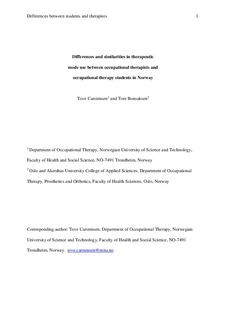| dc.contributor.author | Carstensen, Tove | |
| dc.contributor.author | Bonsaksen, Tore | |
| dc.date.accessioned | 2017-01-09T09:55:15Z | |
| dc.date.available | 2017-01-09T09:55:15Z | |
| dc.date.created | 2016-11-17T09:09:09Z | |
| dc.date.issued | 2016 | |
| dc.identifier.issn | 1103-8128 | |
| dc.identifier.uri | http://hdl.handle.net/11250/2426685 | |
| dc.description.abstract | Background: The Intentional Relationship Model (IRM) is a new model of the therapeutic relationship in occupational therapy practice. Two previous studies have focused on therapist communication style, or ‘mode’ use, but to date no group comparisons have been reported.
Aim: To explore differences between occupational therapists and occupational therapy students with regard to their therapeutic mode use.
Methods: The study had a cross-sectional design, and convenience samples consisting of occupational therapists (n¼109) and of second-year occupational therapy students (n¼96) were recruited. The Self-Assessment of Modes Questionnaire was the main data collection tool. Group differences were analysed with independent t-tests.
Results: The occupational therapists responded more within the collaborative and empathizing modes than the students did. The students responded more within the advocating and instructing modes than the occupational therapists did.
Conclusion and significance: There may be systematic differences between occupational therapists and students concerning their therapeutic mode use. Some modes, such as the collaborating and empathizing modes, may be viewed as requiring more experience, whereas other modes, such as the advocating mode may be related to more recent rehabilitation ideologies. These factors may contribute to explaining several of the group differences observed. | nb_NO |
| dc.language.iso | eng | nb_NO |
| dc.publisher | Taylor and Francis | nb_NO |
| dc.title | Differences and similarities in therapeutic mode use between occupational therapists and occupational therapy students in Norway | nb_NO |
| dc.type | Journal article | nb_NO |
| dc.type | Peer reviewed | nb_NO |
| dc.source.journal | Scandinavian Journal of Occupational Therapy | nb_NO |
| dc.identifier.doi | 10.1080/11038128.2016.1261940 | |
| dc.identifier.cristin | 1401254 | |
| dc.description.localcode | (c) 2016 Informa UK Limited, trading as Taylor & Francis Group. This is the authors' accepted and refereed manuscript to the article. | nb_NO |
| cristin.unitcode | 194,68,30,20 | |
| cristin.unitname | Institutt for helsevitenskap | |
| cristin.ispublished | true | |
| cristin.fulltext | original | |
| cristin.fulltext | postprint | |
| cristin.qualitycode | 1 | |
